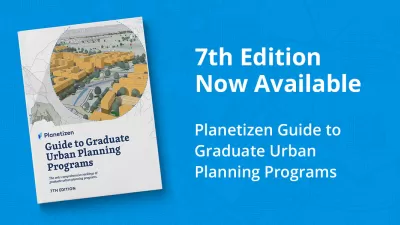Professional doctorates or certificates of advanced graduate study (CAGS) can offer an alternative to a PH.D. for planners looking to expand their education beyond the master's degree.

For decades, the master's degree has been embraced by the planning profession as the best indication for a practitioner's academic preparedness. Obtaining a master's is widely recommended (or even required) in job postings and considered to be the best gateway into the field.
For most planners, adding a master's degree to their list of credentials signals the end of their formal education. Continuing professional development activities tend to focus around GIS workshops, APA conferences, and the occasional seminar at the local college. The Ph.D. is always out there, but few experienced planners are looking to leave their career tracks to spend five to eight years as a student, only to emerge with limited employment opportunities in academia or research. Fortunately, web-based technologies have made possible two new kinds of post-master's graduate programs: professional doctorates and certificates of advanced graduate study (CAGS).
Many professional doctorate and CAGS programs don't require practitioners to quit their jobs or relocate, but they do offer preparation for advanced practice along with the same research training provided by a traditional doctorate (often in much less time). A CAGS is a prestigious post-master's credential used widely in other fields, like education, occupational therapy, and dentistry. In each of those fields, the professional credential (for education, a master's, for dentistry, a DMD or DDS) is followed by a CAGS after gaining substantial professional experience. The CAGS becomes a symbol of advanced training and professional excellence.
Northcentral University, Tufts University, and Northwestern University all have CAGS programs in public policy, public administration, or planning, though each takes on a different structure. Northcentral only offers courses online, which are taught with a 1:1 faculty-to-student ratio. By contrast, the Tufts program implements a cohort model and combines the online with two, one week, on-campus residencies—during the summer before and the summer after the online academic year. As an added bonus, the Tufts program provides the opportunity to fulfill two years of certification maintenance requirements for the American Institute of Certified Planners. The Northwestern University CAGS enrolls new students on a rolling basis for courses offered online, on campus, or a combination of both.
The University of Southern California and Northeastern University offer professional doctorates in planning and public policy. The University of Southern California's professional doctorate is practice-oriented, requires regular residency in Los Angeles for three to four years, and features a capstone research project. At Northeastern University, Dr. Estrella-Luna describes the Doctorate in Law and Policy: "Through structured learning, the program builds up a person's skillset and helps them develop a new understanding that propels their career forward. Students become public academics and solve problems through research." Students take accelerated courses online for two years, but meet with their cohort once a month in Boston during the duration of the program.
While exploring options in continuing education, ask yourself: What is your ideal time commitment? What is your need for flexibility? Do you plan to continue working full-time? What is your working style? Are you hoping to extend your network? These questions might guide you to the type of program best suited to you.
CAGS programs in planning and public policy generally last for one year, while professional doctorates will take at least two years of full-time study and roughly four years of part-time study. Both CAGS and professional doctorates are now offered online and on-campus. Online courses offer more flexibility of when and where you will study, which can be appealing to professionals looking to continue their work. Online courses are great for self-motivated students and self-starters, but because the online format requires self-discipline to stay on top of the material, it can also be a drawback for some students. Online courses don't offer the face-to-face value of a classroom, but that problem has been limited by the expanded use of video calling in virtual classrooms.
Lastly, some programs offer opportunities to be a part of a cohort and others allow students to enroll and study at their own pace. In a cohort model, students admitted together move through the entire program together. Cohort models foster community, innovation sharing, and networking opportunities. A potential drawback of the cohort model is the inability to customize the structure and timing of a program.
Whatever path you take, this new landscape of post-master's education can help you sharpen your skills, satisfy AICP CM credits, and update your credentials. With all these options, you never have to stop learning.
Justin B. Hollander, Ph.D., AICP, is the program director of the CAGS in Urban Justice & Sustainability and an associate professor in the Department of Urban and Environmental Policy and Planning at Tufts University.
Amanda Kohn is a graduate student in the Department of Urban and Environmental Policy and Planning at Tufts University.

Planetizen Federal Action Tracker
A weekly monitor of how Trump’s orders and actions are impacting planners and planning in America.

Maui's Vacation Rental Debate Turns Ugly
Verbal attacks, misinformation campaigns and fistfights plague a high-stakes debate to convert thousands of vacation rentals into long-term housing.

San Francisco Suspends Traffic Calming Amidst Record Deaths
Citing “a challenging fiscal landscape,” the city will cease the program on the heels of 42 traffic deaths, including 24 pedestrians.

Amtrak Rolls Out New Orleans to Alabama “Mardi Gras” Train
The new service will operate morning and evening departures between Mobile and New Orleans.

The Subversive Car-Free Guide to Trump's Great American Road Trip
Car-free ways to access Chicagoland’s best tourist attractions.

San Antonio and Austin are Fusing Into one Massive Megaregion
The region spanning the two central Texas cities is growing fast, posing challenges for local infrastructure and water supplies.
Urban Design for Planners 1: Software Tools
This six-course series explores essential urban design concepts using open source software and equips planners with the tools they need to participate fully in the urban design process.
Planning for Universal Design
Learn the tools for implementing Universal Design in planning regulations.
Heyer Gruel & Associates PA
JM Goldson LLC
Custer County Colorado
City of Camden Redevelopment Agency
City of Astoria
Transportation Research & Education Center (TREC) at Portland State University
Jefferson Parish Government
Camden Redevelopment Agency
City of Claremont





























